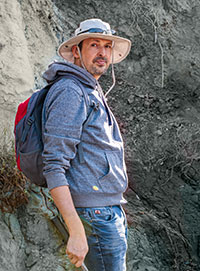 Nicolae Trif. Brukenthal National Museum, Natural History Museum, Cetății St. 1-550160, Sibiu, Romania; and Research Center for Integrated Geological Studies, Mihail Kogălniceanu St. 1-4000084, Cluj-Napoca, Romania. nicolae.trif@gmail.com
Nicolae Trif. Brukenthal National Museum, Natural History Museum, Cetății St. 1-550160, Sibiu, Romania; and Research Center for Integrated Geological Studies, Mihail Kogălniceanu St. 1-4000084, Cluj-Napoca, Romania. nicolae.trif@gmail.com
Nicolae Trif’s research is focused on the fossil fish from the Mesozoic and the Cenozoic. His main interest points are the teeth of marine fishes (especially sharks), but also the fresh water fishes. Currently he is the curator of the Paleontology Collection of the Natural History Museum in Sibiu and a member of the Research Center for Integrated Geological Studies from Cluj-Napoca, Romania. He has a rich field experience, working mostly on the Miocene, Eocene and Upper Cretaceous deposits of Romania.
![]()
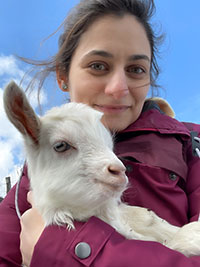 Roxana Pirnea. Independent researcher. roxana.pirnea@gmail.com
Roxana Pirnea. Independent researcher. roxana.pirnea@gmail.com
Roxana Pirnea’s research centers on fossil plants from Romania, with a particular emphasis on their anatomy, leaf architecture, and the systematics of Cenozoic plants. She earned her PhD from the University of Bucharest and currently works as an independent researcher in the private sector. She also volunteers for the Natural History Museum in Sibiu, Romania, driven by her passion for research and paleontology.
![]()
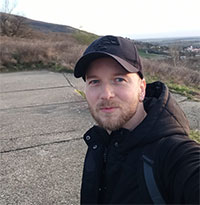 Andrej Čerňanský. Department of Ecology, Laboratory of Evolutionary Biology, Faculty of Natural Sciences, Comenius University in Bratislava, Mlynská dolina, Ilkovičova St. 6-84215, Bratislava, Slovakia; and Institute of Evolutionary Biology, Faculty of Biology, University of Warsaw, Żwirki i Wigury 101, 02-089 Warsaw, Poland. cernansky.paleontology@gmail.com
Andrej Čerňanský. Department of Ecology, Laboratory of Evolutionary Biology, Faculty of Natural Sciences, Comenius University in Bratislava, Mlynská dolina, Ilkovičova St. 6-84215, Bratislava, Slovakia; and Institute of Evolutionary Biology, Faculty of Biology, University of Warsaw, Żwirki i Wigury 101, 02-089 Warsaw, Poland. cernansky.paleontology@gmail.com
Andrej Čerňanský is a Slovak paleontologist and evolutionary biologist interested in the evolution of reptiles, mainly squamates, which help to interpret paleoclimate changes. But his interest is very broad, including amber research and his current topics are: (1) the evolution and diversification of reptiles, (2) anatomy, functional morphology and the evolution of key morphological features, (3) distribution and paleobiogeography of reptiles, (4) Mesozoic and Cenozoic reptiles. He described many fossils and new species from almost all continents, including Europe, Asia (India, Mongolia, Myanmar, Siberia), Australia, Africa and North America. Andrej works at the Comenius University in Bratislava, Slovakia and is also a guest researcher at University of Warsaw in Poland.
![]()
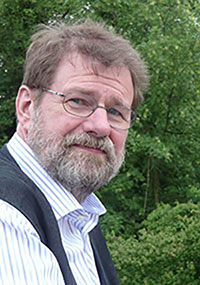 Werner Schwarzhans. Zoological Museum, Natural History Museum of Denmark, Universitetsparken 15-2100 Copenhagen, Denmark. wwschwarz@aol.com
Werner Schwarzhans. Zoological Museum, Natural History Museum of Denmark, Universitetsparken 15-2100 Copenhagen, Denmark. wwschwarz@aol.com
Werner Schwarzhans, of Hamburg, Germany, is an associated researcher with the Natural History Museum of Denmark, Copenhagen. He has worked as a geologist and has studied fossil otoliths and recent fishes and otoliths for 50 years. In 140 scientific publications he has described more than 1000 otolith-based fossil fishes and about 130 extant fish species. Recent work focuses on regional fossil fish faunas on a worldwide scale, aligning skeletal and otolith-based fossil fish taxa through finds of otoliths in situ and systematic reviews of certain groups of extant fishes.
![]()
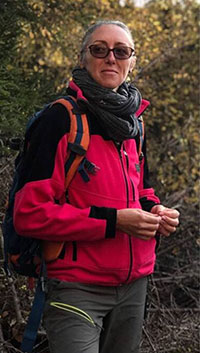 Ramona Bălc. Babeș-Bolyai University, Faculty of Environmental Science and Engineering, Fântânele St. 30-400294, Cluj-Napoca, Romania; and Interdisciplinary Research Institute on Bio-Nano Sciences, Babeș-Bolyai University, Treboniu Laurian St. 42-400271, Cluj-Napoca, Romania; and Center for Risk Studies, Space Modeling and Dynamics of Terrestrial and Coastal Systems, University of Bucharest, Nicolae Bălcescu St. 1-010041, Bucharest, Romania. ramona.balc@ubbcluj.ro
Ramona Bălc. Babeș-Bolyai University, Faculty of Environmental Science and Engineering, Fântânele St. 30-400294, Cluj-Napoca, Romania; and Interdisciplinary Research Institute on Bio-Nano Sciences, Babeș-Bolyai University, Treboniu Laurian St. 42-400271, Cluj-Napoca, Romania; and Center for Risk Studies, Space Modeling and Dynamics of Terrestrial and Coastal Systems, University of Bucharest, Nicolae Bălcescu St. 1-010041, Bucharest, Romania. ramona.balc@ubbcluj.ro
Ramona Bălc is an Associate Professor at Babeș-Bolyai University, within Faculty of Environmental Science and Engineering. Her primary research interests lies in biostratigraphy and paleoenvironmental reconstroction, with a particular focus on calcareous nannoplankton. Her studies encompass a broad geological time span, from the Jurassic to the Neogene periods. She collaborates extensively with specialists in related fields, including foraminifera, palynology, vertebrate and fish paleontology, geochemistry, etc.
![]()
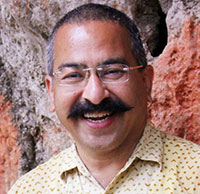 Sreepat Jain. Department of Geology, School of Applied Natural Science, Adama Science and Technology University, Adama St. 1888, Oromia, Ethiopia. sreepatjain@gmail.com
Sreepat Jain. Department of Geology, School of Applied Natural Science, Adama Science and Technology University, Adama St. 1888, Oromia, Ethiopia. sreepatjain@gmail.com
Sreepat Jain is a full-time professor at the Adama Science and Technology University, Ethiopia, with over 25 years of research experience. He works extensively in collaboration with international scientists in multidisciplinary fields covering various aspects of paleontology (ammonites, benthic and planktic foraminifera, calcareous nannofossils, crinoids, and trace fossils), sedimentology, sequence stratigraphy, and stable isotopes stretching from the Triassic to the recent, with emphasis on the Jurassic–Cretaceous. He has also published over 100 high-impact factor research papers and five books. Three of his books (Fundamentals of Physical Geology, Fundamentals of Invertebrate Paleontology: Macrofossils, Fundamentals of Paleontology: Microfossils) have received excellent international reviews and are used worldwide as text or reference books. His fourth book, Fundamentals of Sedimentology, has just been published by CRC Press (Taylor and Francis Group). Prof. Jain has received several awards and scholarships such as the DAAD-DST Exchange Scholar, Institute for Palaeontology, Wurzburg (Germany) on a DAADDST (Deutscher Akademischer Austauschdienst—Department of Science and Technology), TA Excellence in Teaching (Florida, USA), Prof. S. K. Singh Memorial Gold Medal in India for his academic research paper by the Paleontological Society of India, and Fast Track Grants 2.0 Back2Mobility visiting scholarship by the University of Silesia (Poland), among others. He also serves as a reviewer, associate editor, and guest editor of several national and international research journals. He is also part of the editorial advisory group of the reputed journal – Lethaia (Scandinavian Press).
![]()
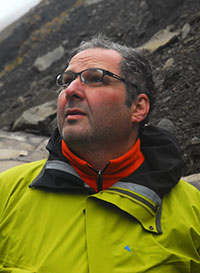 Andrzej Kaim. Institute of Paleobiology, Polish Academy of Sciences, ul. Twarda 51/55, 00-818, Warsaw, Poland. kaim@twarda.pan.pl
Andrzej Kaim. Institute of Paleobiology, Polish Academy of Sciences, ul. Twarda 51/55, 00-818, Warsaw, Poland. kaim@twarda.pan.pl
Andrzej Kaim is a paleontologist and malacologist, specializing in the evolution, phylogeny, and ontogeny of mollusks (gastropods in particular) and the evolution of marine ecosystems. He is also an expert on faunal assemblages based on chemosynthesis (including hydrocarbon seeps and hydrothermal vents, and on vertebrate falls and sunken wood) in the fossil record. Evolution of Marine Ecosystems Research Group at the Institute of Paleobiology, Polish Academy of Sciences in Warsaw, Poland.
![]()
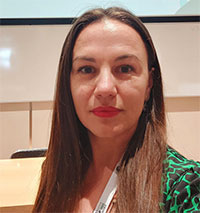 Sofia Bakayeva. Institute of Paleobiology, Polish Academy of Sciences, ul. Twarda 51/55, 00-818, Warsaw, Poland; and State Museum of Natural History, National Academy of Sciences of Ukraine, Teatralna St. 18, 79008, Lviv, Ukraine. sofiyabakayeva@gmail.com
Sofia Bakayeva. Institute of Paleobiology, Polish Academy of Sciences, ul. Twarda 51/55, 00-818, Warsaw, Poland; and State Museum of Natural History, National Academy of Sciences of Ukraine, Teatralna St. 18, 79008, Lviv, Ukraine. sofiyabakayeva@gmail.com
Sofia Bakayeva is a paleontologist focusing on Mesozoic gastropods, studying their diversity and distribution. She traces the emergence and evolution of predatory snails from the order Neogastropoda and analyses possible phylogenetic relationships among them, based on fossil material collected from various parts of the world. Her research combines taxonomy, paleoecology, and biogeography to investigate patterns of marine biodiversity reorganization during major turnover intervals. She serves as curator of the paleontological and geological collections at the State Museum of Natural History in Lviv, Ukraine. She currently holds a research grant at the Institute of Paleobiology in Warsaw, Poland. In addition to her research, she collaborates with international teams on fieldwork and fossil documentation, and contributes to science communication and education.
![]()
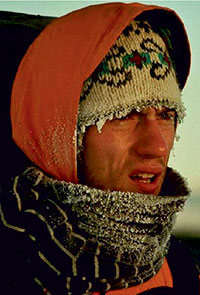 Krzysztof Hryniewicz. Institute of Paleobiology, Polish Academy of Sciences, ul. Twarda 51/55, 00-818, Warsaw, Poland. krzyszth@twarda.pan.pl
Krzysztof Hryniewicz. Institute of Paleobiology, Polish Academy of Sciences, ul. Twarda 51/55, 00-818, Warsaw, Poland. krzyszth@twarda.pan.pl
Krzysztof Hryniewicz is a geologist and paleontologist with expertise on systematics, evolution and phylogeny of ancient bivalves, especially from marine settings. He also specializes in chemosynthesis-based ecosystems (hydrocarbon seeps, hydrothermal vents, and vertebrate and wood falls), both fossil and Recent. Evolution of Marine Ecosystems Research Group at the Institute of Paleobiology, Polish Academy of Sciences in Warsaw, Poland.

